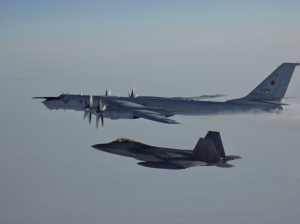The U.S. Air Force (USAF) and Royal Canadian Air Force (RCAF) scrambled fighter jets to intercept two Russian Tupolev Tu-142MZ maritime reconnaissance and anti-submarine warfare aircraft off the coast of Alaska on March 9, North American Aerospace Defense Command (NORAD) said in a statement.
The two Russian aircraft were intercepted by USAF F-22 Raptors and RCAF CF-18s, a variant of the U.S. Navy’s F/A-18 Hornet, in the Alaskan Air Defense Identification Zone (ADIZ).
“The Russian aircraft entered the ADIZ north of Alaska and remained within it for approximately 4 hours,” according to the statement. “NORAD fighter aircraft escorted the TU-142s for the duration of their time in the ADIZ.”
The USAF and RCAF fighters were supported by a Boeing E-3 Sentry airborne early warning and control (AEW&C) aircraft and a KC-135 Stratotanker. The Russian aircraft reportedly did not violate U.S. or Canadian airspace.
“The Russian aircraft remained in international airspace over the Beaufort Sea, and came as close as 50 nautical miles [92 kilometers] to the Alaskan coast,” the NORAD statement reads. “The Russian aircraft did not enter United States or Canadian sovereign airspace.”
NORAD released pictures of the U.S. and Canadian fighter jets escorting the Russian aircraft. The Russian spy planes were likely mapping NORAD’s air defense network and collecting signals intelligence.
“NORAD continues to operate in the Arctic across multiple domains,” said General Terrence J. O’Shaughnessy, NORAD commander. “As we continue to conduct exercises and operations in the north, we are driven by a single unyielding priority: defending the homelands.”
The latest variant of the Tu-142 currently in service with Russian Naval Aviation, the Tupolev Tu-142MZ reportedly features a modern avionics suite, advanced anti-submarine warfare equipment, and new NK-12MP engines.
The Russian Navy deploys around 14 Tu-142MZ aircraft, although it is unclear how many of them are operational and flightworthy. Overall, the Russian Naval Aviation inventory of Tu-142s of all variants consists of approximately 24 aircraft.
Two Tupolev Tu-142MZ aircraft of the Russian Pacific Fleet entered the Alaskan ADIZ at the beginning of August 2019. The aircraft were escorted by a pair of MiG-31BM fighter-interceptors for a part of their mission. The Russian aircraft were identified electronically via NORAD’s early warning system radars.
Last August, the USAF and RCAF also intercepted two Russian Tupolev Tu-95 strategic bombers off the coast of Alaska. The Tu-95MS is an upgraded version of the original Tu-95, a Soviet-era four-engine, long-range, turboprop, strategic bomber that can carry stand-off missiles including the Kh-101/Kh-102 (nuclear variant) air-launched cruise missile or the Kh-55 subsonic air-launched cruise missile.

































